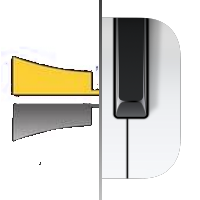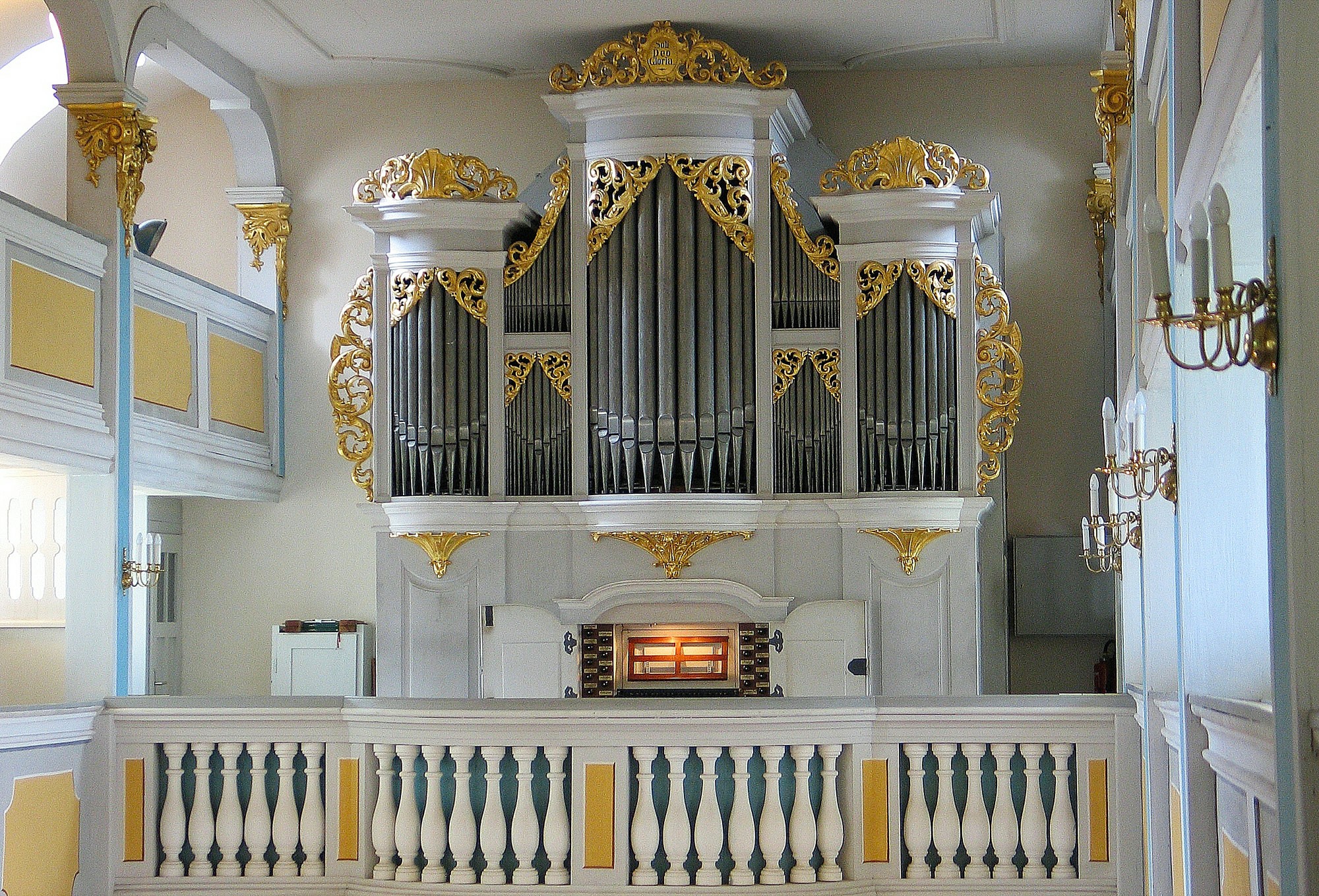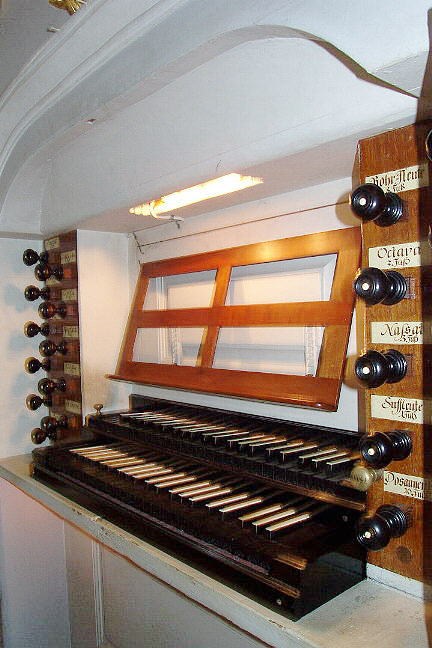Reinhardtsgrimma, Dorfkirche
| Builder | G. Silbermann |
|---|---|
| Year | ca. 1731 |
| Period/Style | Baroque |
| Stops | 20 |
| Keyboards | 2+P |
| Keyaction | tracker/mechanical |
| Tuning | 1/6 Comma Meantone at 465 Hz |
| Sampleset |
Available
 , sampled by
OrganArt Media
, sampled by
OrganArt Media
|
The instrument is located in a historic village church in eastern Germany near Dresden. The current church is based on a 13th-century structure that has been repeatedly modified and expanded over the centuries, with the last major renovation occurring in 1742. The church's acoustics are very dry and clear due to numerous wooden fixtures.
The organ was built between 1729 and 1731 by Gottfried Silbermann from Frauenstein/Saxony. Silbermann organs can be classified into different architectural types, and this particular instrument represents the medium-sized village organ type. It was a favorite instrument of Helmut Walcha and the Dresden Kreuzorganist Herbert Collum. Typical features of Silbermann organs include strong and sharp aliquots like 1 1/2' and 3', full and warm 8' principals, and bright super octave stops like 4', 2', and 1'. Notable expressive stops include the 8' Rohrflöte and 8' Quintadena. The plenum sound is clear and very powerful, requiring few stops to achieve this effect.
The organ is tuned to the so-called historical Chorton (a1=465 Hz). Almost all pipes are original, especially the façade pipes (Principal 8). Many historical organs lost their façade pipes due to requisitioning during World War I. However, this instrument has undergone several significant interventions, such as in 1852 when pipes were cut and re-set for equal temperament. A free pedal coupling was added, and the intonation was partially altered to suit contemporary tastes. In 1909, even a Salicional 8' stop on a pneumatic auxiliary chest was added.
In 1953, the wind pressure was drastically reduced from 94 mm to 70 mm, necessitating major intonation changes. The result was a noticeably weaker and wind-unstable organ, as evidenced by a historical recording from that time featuring Herbert Collum. In 1997, the organ-building workshop Wegscheider from Dresden was commissioned to restore and reconstruct the organ, reinstating the original wind pressure and system, and reversing the altered intonation, made possible by a generous donation from a patron.
Since the original tuning was lost, a tuning by Wegscheider, inspired by Silbermann, was adopted. This tuning is intended to support the accompaniment of baroque chamber music and is characterized by pure fundamental tones. The instrument, with its two manuals and pedal, mechanical action and registration, and a manual coupler, is fully playable and in excellent condition.
The organ was built between 1729 and 1731 by Gottfried Silbermann from Frauenstein/Saxony. Silbermann organs can be classified into different architectural types, and this particular instrument represents the medium-sized village organ type. It was a favorite instrument of Helmut Walcha and the Dresden Kreuzorganist Herbert Collum. Typical features of Silbermann organs include strong and sharp aliquots like 1 1/2' and 3', full and warm 8' principals, and bright super octave stops like 4', 2', and 1'. Notable expressive stops include the 8' Rohrflöte and 8' Quintadena. The plenum sound is clear and very powerful, requiring few stops to achieve this effect.
The organ is tuned to the so-called historical Chorton (a1=465 Hz). Almost all pipes are original, especially the façade pipes (Principal 8). Many historical organs lost their façade pipes due to requisitioning during World War I. However, this instrument has undergone several significant interventions, such as in 1852 when pipes were cut and re-set for equal temperament. A free pedal coupling was added, and the intonation was partially altered to suit contemporary tastes. In 1909, even a Salicional 8' stop on a pneumatic auxiliary chest was added.
In 1953, the wind pressure was drastically reduced from 94 mm to 70 mm, necessitating major intonation changes. The result was a noticeably weaker and wind-unstable organ, as evidenced by a historical recording from that time featuring Herbert Collum. In 1997, the organ-building workshop Wegscheider from Dresden was commissioned to restore and reconstruct the organ, reinstating the original wind pressure and system, and reversing the altered intonation, made possible by a generous donation from a patron.
Since the original tuning was lost, a tuning by Wegscheider, inspired by Silbermann, was adopted. This tuning is intended to support the accompaniment of baroque chamber music and is characterized by pure fundamental tones. The instrument, with its two manuals and pedal, mechanical action and registration, and a manual coupler, is fully playable and in excellent condition.
| Hauptwerk | Hinterwerk | Pedal |
|---|---|---|
| Principal 8. Fuß | Gedacktes 8. Fuß | Sub Baß 16. Fuß |
| Rohr=Fleute 8. Fuß | Rohr=Fleute 4. Fuß | Octaven Baß 8. Fuß |
| Qvinta dena 8. Fuß | Nassat 3. Fuß | Posaunen Baß 16. Fuß |
| Octava 4. Fuß | Tertia 2. Fuß | |
| Spiz=Fleute 4. Fuß | Octava 2. Fuß | |
| Qvinta 3. Fuß | Qvinta 1 1/2 Fuß | |
| Octava 2. Fuß | Suffleute 1. Fuß | |
| Mixtur 4. Fach | Zymbeln 2. Fach | |
| Cornett 3. Fach |
KrebsPrelude-Fugue in C
0:00
0:00
WaltherConcerto Meck
0:00
0:00
WaltherConcerto Albinoni
0:00
0:00
https://www.organartmedia.com/de/gottfried-silbermann
 Pipe Organ Map
Pipe Organ Map
